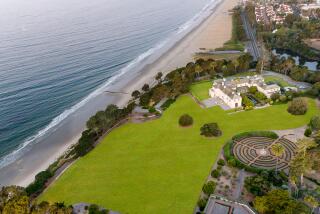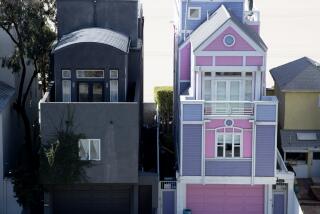Far removed from her seaside jewel
- Share via
Reporting from Santa Barbara — If Huguette Clark can remember her younger days, she may fondly recall the Santa Barbara estate where a private railroad car deposited her family every winter.
At 104, she may linger on memories of debutante parties and society luncheons, or of musicales featuring the Paganini Quartet, equipped with Stradivarius instruments courtesy of her mother.
Then again, she may not remember a thing. She resides at a New York hospital — her home for more than 20 years.
By all accounts, it’s been at least half a century since she last set foot in the 22,000-square-foot house that for years was tended as if a telegram might at any moment signal Clark’s arrival.
Perched on a seaside bluff, Bellosguardo — Italian for “beautiful view” — gazes out onto the same stunning panorama that Clark and her guests enjoyed at garden parties in the 1920s.
The 23-acre estate is worth at least $100 million. Real estate brokers who specialize in luxury properties say Clark’s representatives have turned away overtures from at least two billionaires. There are rumors — maybe wishful thinking — that Bellosguardo will be given to the city, a school, a charity.
Or perhaps it will sit in cloistered grandeur — like its owner — for years to come.
Money and advisors
Huguette Clark is the daughter of William Andrews Clark, who left behind a Rockefeller-scale fortune. Her ex-husband is long gone, and she doesn’t have children or close relatives. What she does have is an estimated $500 million and advisors who have been accused of mismanaging her wealth for their own gain.
Her holdings are baronial. There’s a mansion in New Canaan, Conn., and two apartments — 42 rooms altogether — in one of Fifth Avenue’s swankiest buildings. And then there’s Bellosguardo.
Today, a caretaker and a hired landscaping crew maintain the acreage. Long ago, the hillside was humming with 25 full-time gardeners and a large household staff. For a time, cows grazed at Bellosguardo; when the Clarks were elsewhere, fresh Santa Barbara butter was flown to them.
Barbara Hoelscher Doran, who lived in a house on the estate until she was 12, remembers those days well. The daughter of the property’s former manager relishes her memories of Huguette: “She’d call and ask my mother, ‘Can Barbie come over for tea?’”
Delighted, the little girl would run up to the big house, past rose gardens, fresco-adorned walls and a reflecting pool. To avoid marring the parquet floors inside, she would don special slippers — “the kind of things surgeons wear.”
Here was the music room, with its two gold harps and back-to-back grand pianos; there, the fan room, where Huguette Clark’s mother, Anna, showed off ladies’ fans she had collected from around the world. The dining room walls were intricately carved — all from a single tree in the Black Forest — and, when pressed in the right places, would open to reveal shelves of fine china.
On the patio, Doran would take tea, often going home with exquisite dolls, children’s books in French and other gifts from Huguette and Anna.
“They were the most lovely, kind, soft-spoken ladies,” said Doran, who, four decades later, manages an interior design business in Montecito. “It was idyllic; I just didn’t realize it at the time.”
A tycoon’s bauble
Long before Bellosguardo became a little girl’s enchanted playground, it was a bauble for William Andrews Clark — a mining tycoon with a much younger wife, eight children from two marriages and a larger-than-life love of luxury.
Already 84 when he acquired the grand home in 1923, Clark was accustomed to the finer things. His main house, on New York’s Fifth Avenue, had 121 rooms, Turkish baths, art galleries and a railroad spur for coal cars.
By comparison, Bellosguardo was a shack — but one where his wife could entertain in high style. To celebrate the arrival of relatives, she once threw the house open for a lavish midnight dinner — but Clark sat in his study, “scowling like an ancient bird of prey,” according to local author Marshall Bond Jr.
Just two years after buying Bellosguardo, he died. His obituaries recalled his one term as a U.S. senator from Montana, pointing out that he secured it with gifts to legislators that included cash stuffed into monogrammed envelopes. “I never bought a man who wasn’t for sale,” he once said.
Though corrupt, Clark was generous. He donated priceless paintings to the Corcoran Gallery of Art in Washington, D.C. His son William Andrews Clark Jr. founded the L.A. Philharmonic and gave UCLA a rare-book library named for his father.
After Huguette’s sister died of meningitis, the family gave Santa Barbara land and money for the Andree Clark Bird Refuge.
Even Bellosguardo became an exercise in philanthropy.
In 1932, Huguette’s mother was adding a wing to the 30-year-old house. When her architect praised her for providing jobs in hard times, she decided to create many more by tearing down the entire home and rebuilding it in a French country style.
One of her new workers was Doran’s father, an electrician who managed Bellosguardo until his death 50 years later.
Into the limelight
Doran lived at Bellosguardo until her parents separated. She summered there as a teenager and, until about 10 years ago, exchanged cordial, if infrequent, notes with Huguette.
By then, the frail Clark had left her lavish New York apartment for round-the-clock institutional care. She collected dolls, directing her attorneys to pick them up at high-stakes auctions. According to one report, she negotiated with an antiques dealer only through a closed door.
But last year, an investigation by MSNBC.com thrust Clark and her holdings into the limelight.
A series of reports suggested that she was being exploited by her longtime attorney, Wallace Bock, and her accountant, Irving Kamsler. As a result, three distant relatives asked a judge to name a guardian for her.
The relatives, whose request was denied, were upset that Kamsler had pleaded guilty to charges of e-mailing pornography to teenage girls. They also questioned Clark’s $1.5-million donation to an Israeli settlement where Bock’s daughter lived with her family.
In court documents, Bock called the relatives “officious interlopers … with whom Ms. Clark has knowingly and assiduously avoided contact for decades.” Clark’s gift was for the community’s security system, Bock said, reflecting her “continued interest in my daughter and her family’s safety.”
Bock did not return phone calls. Kamsler’s attorney, Elizabeth Crotty, said he “has acted both professionally and diligently.”
Still, prosecutors are investigating how Clark’s fortune has been handled, according to a New York law enforcement source not authorized to discuss the case publicly.
In Santa Barbara, Bellosguardo remains, as always, hidden from public view.
Doran said she last saw the house about 10 years ago, after writing Huguette for permission. The windows had been opened for her. There were dust covers on the old furniture, and the double stairway was still adorned in gold leaf.
“It could be a museum,” she said. “But it’s too fine. It couldn’t bear that much traffic.”
More to Read
Sign up for Essential California
The most important California stories and recommendations in your inbox every morning.
You may occasionally receive promotional content from the Los Angeles Times.














![Vista, California-Apri 2, 2025-Hours after undergoing dental surgery a 9-year-old girl was found unresponsive in her home, officials are investigating what caused her death. On March 18, Silvanna Moreno was placed under anesthesia for a dental surgery at Dreamtime Dentistry, a dental facility that "strive[s] to be the premier office for sedation dentistry in Vitsa, CA. (Google Maps)](https://ca-times.brightspotcdn.com/dims4/default/07a58b2/2147483647/strip/true/crop/2016x1344+29+0/resize/840x560!/quality/75/?url=https%3A%2F%2Fcalifornia-times-brightspot.s3.amazonaws.com%2F78%2Ffd%2F9bbf9b62489fa209f9c67df2e472%2Fla-me-dreamtime-dentist-01.jpg)